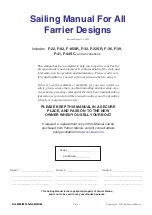
FARRIER MARINE
Page 9
Copyright © 2012 By Farrier Marine
Remove raising pole etc., rewind the
winch and reconnect hook to the bow
eye.
Leave rotating mast raising wires
attached to the mast
, as these may still
be required for support until after the
floats are unfolded and stays are prop-
erly connected to floats.
14.
The topping lift is now discon-
nected from the mast lower end and
connected to the end of the boom to help
take the weight. Remove the sail bag
from the mainsail/boom and connect the
boom to the mast.
15.
Tighten all the battens in the
mainsail, if required. Connect the main-
sheet to the boom. Feed the mainsail
head into the track on the mast and connect the main
halyard
16.
If required, run all the halyard lines from the mast
through the turning blocks back to the correct rope
clutches on the aft end of the cabin roof.
17.
Connect the mast electric plug if required.
18.
The headsail can be fitted now if wished, or after
launching. The sheets are laid out and connected to the
clew (sheets can be kept in the anchor well for quick
access). The headsail can be kept under control by a
shockcord which can be left on the foredeck for this
purpose. Just keep it hooked to the toerail or pulpit.
19.
Fit or untie rudder so it is ready for use (still
retracted), and check that daggerboard up-line is cleated.
O
utboard
motor should also be in the
up position
.
20.
The aft mast support is now removed and stored.
WARNING
Before taking boat to the water check there are no
powerlines that the mast could touch
LAUNCHING
Back the trailer down the ramp until the trailer is
submerged up until just past the inward bend of the side
frame members (about 6 to 8' back from the winch post).
Disconnect winch hook and push the boat off while
holding on to the bow line, or you can get on board
(having started the motor first). Be careful of crosswinds
or wind from the stern. The boat, with its shallow draft, will
move quickly sideways in such conditions, and you
should not launch until there is sufficient maneuvering
room alongside.
This ability to go sideways is one drawback of shallow
draft, and you should always make allowances when
launching/retrieving or under power.
First priority
at
every launch should be to
LOWER DAGGERBOARD!
This helps to prevent any sideways movement, and gives
excellent maneuverability under power.
Some models are large boats to handle at ramps, but
because of their lightness, are easy to move around. The
trick is not to fight it, but to plan ahead what you are going
to do, and gently guide it in the correct direction.
An offshore wind at the ramp is ideal, as the boat will
lie quietly downwind at the end of the bow line. It 's then
just a simple matter of boarding over the float bows, and
backing off or just walking her over to a boarding dock, if
available.
An onshore wind is the most difficult, as the boat will
swing sideways once launched, and come towards the
ramp. In this situation the boat should be held off the ramp
from a central position on the side. You will find a balance
point where it will lie evenly until you are ready to board.
If a dock is alongside it is a good idea to run a stern line
to the dock, so that the stern can be pulled to the dock
after launching, thus preventing it from swinging around.
A good way of launching in all conditions, if extra help
is available, is for someone on board to start the motor
before launching, and simply back the boat away from the
ramp, remembering to immediately drop the dagger-
board once clear of trailer.
Launching an F-33
Содержание F-22
Страница 42: ......
























